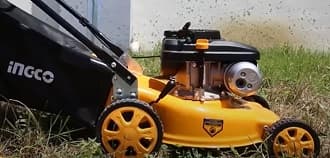As an Amazon Associate, this site earns commissions from qualifying purchases. For more information click here.
Gas lawn mowers are still popular, but I have seen a lot of people switch over to battery models. This isn’t surprising. Battery mowers are cheaper, need less maintenance and less noisy. They are also powerful. But will an AGM battery work or not? Those are the questions I will answer here.
Lawn mowers use different types of batteries including AGM. AGM is an advanced type of lead acid battery that provides longer running times and better performance compared to standard lawn mower batteries.
What Batteries Do Lawn Mowers Use?
There are four types of batteries you will find in lawn mowers: lead acid, AGM, gel and lithium. Each one has its own pros and cons which I will go over. Briefly though:
Lead acid. This is the most widely used. If you read a lawn mower uses “standard batteries”, it refers to lead acid. These batteries are affordable, which explains their popularity.
But lead acid batteries are maintenance heavy and have a shorter running time compared to AGM. Lead acid batteries are also known as FLA (flooded lead acid).
AGM. An AGM (absorbent glass mat) is a more sophisticated type of lead acid battery. iI is maintenance free and offers superior performance. It is also known as an SLA (sealed lead acid) battery.
Gel. Gel is another SLA battery and is often compared to AGM. Both offer superior performance to FLA but do cost more.
Lithium. Lithium batteries offer high performance, fast charging, long life and no maintenance. These are also more expensive than the other batteries. There are two types, lithium ion and lithium phosphate.

Why AGM Batteries are Good For Lawn Mowers
If your lawn mower supports AGM batteries, you should use it. There are a lot of benefits for the mower and also for you.
Compatibility. AGM batteries are compatible with rider mowers, push lawn mowers, tractors, zero turn lawn mowers and more. If you own different types, you can find an AGM battery that works for it.
Low maintenance. AGM batteries are spill proof. FLA batteries need maintenance to avoid electrode flooding. The glass mat on AGMs prevents this by securing the electrolytes. This allows you to focus on lawn mower maintenance instead of the battery.
Fast charging. Nobody likes waiting for batteries to charge when there is a lawn to be mowed. AGM batteries like the Chrome Battery 12V 35AH SLA are five times faster than the standard lawn mower battery.
No sulfation. Sulfation is the buildup of lead sulfate crystals, which usually happens if the battery is not 100% charged. When this happens, lead acid batteries become less effective. This is the reason why flooded lead acid batteries have to be charged at least every 6 months.
AGM batteries do not have this problem. You can store the battery for long periods without the need to charge it.
Built to last. AGM batteries were originally built for use in planes. They can withstand temperature swings and vibrations. If the battery can handle military aircraft, it can handle your lawn. So not only are AGM batteries zero maintenance, but they are also durable.
Minimal discharge. AGM batteries are designed to minimize self-discharge. What this means for you is a longer lifespan. Self-discharge is a common battery problem, but I can tell you that it’s less of an issue with AGM.
High capacity. These batteries can last for a long time. If you have to mow large lawn, this is the kind of battery that can help. You do not have to worry about recharging over and over just to get the grass cut.
If you want to try an AGM battery for your lawn mower, I recommend the ML-U1-CCAHR. It is an effective, fst charging AGM battery and also reliable.
AGM vs. Lead Acid Lawn Mower Batteries
So far we have seen the benefits of an AGM powered lawn mower. So bow does it stack up with a standard lead acid battery?
AGM costs more than lead acid batteries, but it offers better performance. It lasts longer, charges faster and does not need maintenance.
AGM batteries have a deeper depth of discharge than lead acid because of its glass mat. It stops sulfation and also makes the battery last longer. Its internal resistance is lower than lead acid and is easier to store.
From a practical standpoint I can point other advantages an AGM has over FLA batteries. As stated earlier, AGM batteries can handle vibration better than lead acid.
If your mower runs into rocks, an AGM battery would survive that. Lead acid is more sensitive to that and could get damaged if the bump was hard enough.
An AGM battery charges faster and lasts up to five times longer than lead acid. It has a better life cycle and more durable. Lead acid batteries are also heavier. No matter which battery you use, make sure that it is the right size for your lawn mower.
AGM vs. Gel Batteries
Gel is another SLA battery like AGM. The two have a lot in common and are sometimes mistaken for each other. There are similarities yes, but also differences.
The most important difference is this. AGM batteries wick electrolytes in its fiberglass mat. A gel battery suspends the electrolyte in the casing. The AGM approach is more effective in preventing spills and is safer.
AGM batteries cost less and runs fine on high voltage. Gel batteries are more exacting when it comes to voltage. While gel batteries are superior to lead acid, AGM is better than both.
AGM vs. Lithium Batteries
A growing number of lawn mowers now use lithium batteries. If your rider runs on AGM, is it time to make the switch? It depends on your requirements. To make this easier, let us compare the two over the most important categories.
Depth of discharge. Lithium batteries have a DOD of 90-95%, and AGM from 50-80%. This means a lithium battery can run a lawn mower longer on one charge than AGM. If you mow for long periods, lithium is the better choice.
Lifespan. A lithium battery is good for 300 charging cycles on the low end and up to 4000 charging cycles for others. AGM cycles range from 200-750. Another way to look at it is that a lithium battery is good for 10 years. An AGM battery lasts 1-3 years.
I want to point out that these numbers assume you follow the DOD recommendation. If you let the battery discharge below the suggested DOD level, its lifespan shortens. This applies to all batteries.
Charge time. Lithium batteries charger faster than AGM. It can be twice as fast in some cases. Lithium batteries also charge up to 95% without any voltage fluctuation. This is not the case with AGM and other lead acid batteries.
Weight. Lithium batteries are much lighter than AGM. A 105 ah AGM battery weighs 61.7 lbs. while a 60 ah lithium battery weighs 17 lbs. And both batteries have the same capacity. So not only are lithium batteries lighter, but they have more capacity.
Cost. All those advantages of lithium batteries come at a price. It is more expensive than AGM. The cost might be double or more depending on the specs.
What Lawn Mower Battery Should You Use?
Now that you know the pros and cons of the four battery types, which one is best for your lawn mower?
If you rarely mow the lawn and don’t mind the maintenance, a lead acid battery is a good choice. It is inexpensive and widely available. If you use your lawn mower often, an AGM battery is better as it doesn’t require maintenance. If you want the best battery, go with lithium.
Regardless which battery you choose, make sure that it is compatible with your lawn mower. Check the owner’s manual so you can avoid problems later on. And always charge the battery – no matter what type – as per the manufacturer recommendations.

I love the outdoors and all the tools for maintaining gardens, yards and lawns. The only thing I am more passionate about is sharing what I know about garden and outdoor equipment.


